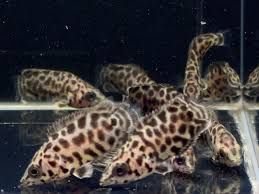Leopard Bush Fish
Leopard Bush Fish Care Guide
Tank Setup
-
Tank Size: Minimum 120 liters (30 gallons) for one adult; larger if keeping more.
-
Substrate: Dark sand or fine gravel helps bring out their striking colors.
-
Décor: Provide plenty of hiding spots with driftwood, rocks, and dense planting. Floating plants are highly recommended to diffuse light and mimic their natural shaded habitats.
Water Parameters
-
Temperature: 23–28°C (74–82°F)
-
pH: 6.0–7.5
-
Hardness: 5–20 dGH
-
Filtration: Gentle flow preferred, as they come from slow-moving waters.
Diet
-
Predatory by nature – feed them a varied diet of live or frozen foods such as bloodworms, shrimp, small fish, and insects.
-
They may accept high-quality carnivore pellets, but live/frozen food should remain the staple.
Tank Mates
-
Semi-aggressive and predatory. Best housed with similarly sized or larger fish.
-
Avoid small species (like neon tetras or guppies) as they may become prey.
-
Good companions include larger cichlids, robust catfish, or similarly sized gourami-type fish.
Behavior
-
Nocturnal ambush predators; they prefer dim lighting and often hide during the day.
-
Slow-growing but can reach up to 20 cm (8 inches).
-
Best kept as singles or in large enough aquariums with careful stocking.
Interesting Fact
The Leopard Bush Fish belongs to the Anabantidae family and has a special labyrinth organ, allowing it to breathe atmospheric air. This adaptation lets it survive in oxygen-poor waters where other fish would struggle.

